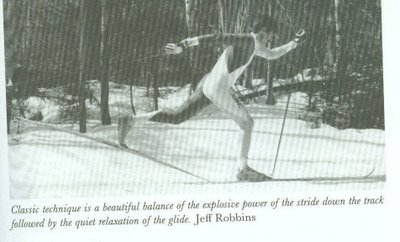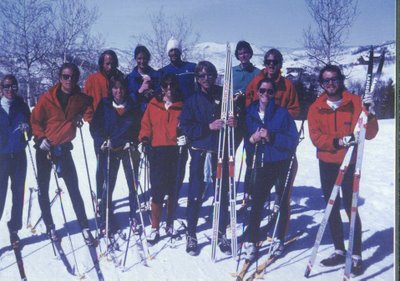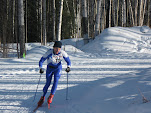Tracking The Skate Revolution's Western Front 1983-84
After a year of trapping and tracking wolves for research in
I had been an enthusiastic alpine skier since the age of 5, growing up on
Although I was in the best shape of my life in 1983 and posted a sub 33 10k at 6,000 feet altitude and a 2:34 marathon at 5,000 feet, I finished far behind the leaders in the occasional citizens ski race that I’d enter. Broken down from 3,000 miles of running and two marathons by the end of the year, I decided to finally get some decent equipment and join the Colorado State University Nordic ski team, for grins if nothing else.
By the end of 1983, the marathon skate was a commonly used technique among elite Nordic skiers, and even some general sports enthusiasts had heard of Bill Koch and his exploits on the international circuit. Nevertheless, our early on-snow training emphasized lots of over-distance using the traditional (or classic) kick and glide technique. One team advisor even suggested that the marathon skate was over-rated.
What’s This About Slam Dancing?
I had spent the summer of 1982 taking an intensive field course at the Colorado University Mountain Research Station, located at 9,200 feet elevation on Niwot Ridge near
Meanwhile, I had always wanted to telemark and figuring that at 24 I’d taken the alpine skiing about as far as feasible. Extreme skiing, alpine racing, or freestyle competition didn’t seem as fun as the free-wheeling recreational mogul bashing and tree skiing that I had been used to, but the prospect of hitting a tree or busting a knee on a mogul would not make for a healthy and independent lifestyle. And lift tickets? Forget about it, they were approaching $25 a day, $30 at
However, something happened between those heady low oxygenated days on Niwot Ridge and the sun baked foothills and prairie of
CSUs Team
Our team leader, Franz Froelicher, was guru skier-coach who always had a funny story up his sleeve, was laid back about everything, except skiing where he was an intense competitor. Franz had had near flawless classic technique, save for skiing a little knock-kneed due to a crushed ankle from a rock climbing fall that nearly took his life a few years prior. At 130 pounds he was our slightly built bionic skier.
Classic Photo from Morton (1992) Don't Look Back
Also a good skier, Chris Hofer was an easy-going
John Holcomb (also known as “Ho-hum”) a nickname given by his cyclist friends was so laid back that you’d think he was falling asleep in the middle of a conversation, but watch out when you put him on a bike (he was national class in that sport) or skis, because he was always a scrappy competitor with bottomless lung capacity.
Rounding out our top five for most of the year was Parker, who was insouciant and smart-mouthed. If you looked at him in the right angle, he might even look like Franz’s twin, but Parker had a leg-length discrepancy that made himself three-times more knock-kneed. In a strangely idiosyncratic way, Parker was the spirit of our team of goofy, over-aged (Holcomb was the youngest at 22) college skiers.
Early on we had a true freshman, 18 year old Paul, who was trying to qualify for Junior Olympics. But he moved on after our first race to focus on the JO races and probably to look for more mature company.
Although he wasn’t officially part of the squad, Ray Sharp, a world class and
The unofficial rite of passage for the team was ski camp in
Sleep on the first night of camp was near impossible, but we still put in 2.5 hours on the second day. That night I found a little corner space after dinner and slept for 12 hours, with teammates checking in a couple times to see if there was still a pulse. By the third day, Parker and several younger skiers could take no more and they cleared out of that rat's nest. Parker would return for the rest of the season, but a couple of the others never came back.
Through blizzards and sub zero temperatures we traveled in Ray’s 1970s VW bus and trained on the trails at Devil’s Thumb, Snow Mountain Ranch, Silver Creek, and in
Winter Season 1984
The college season began in January, under record-breaking snow and cold, and even though my technique and placings had improved tremendously from previous years, I finished well back in the early races and did not make the team's top 3 to qualify for the 3 X 5k relay. However, at the end of the month in  or technical climbs, which made it perfect for the marathon skate.
or technical climbs, which made it perfect for the marathon skate.
Marathon Skate Photo from Morton (1992) Don't Look Back
Like a skateboarder using their rear leg to push themselves down a sidewalk, marathon skate is a pretty simple endeavor. A weight shift is required, but the transfer is not always complete. While my competitors, all good classic skiers, did the diagonal stride most of the way, I instinctively marathon skated as much as I could and finished the 5k with a surprisingly fast split, 2nd fastest on the team, and one of the fastest overall. Seemed like a big breakthrough, but one that didn’t fully arrive for more than a year.
Back on campus and into our classes, we had less time to travel to Nordic centers on the
Most memorable about those sessions, was Pekka, a middle-aged Finlander (Finnish-American from the upper Midwest) and former
As a decent, but not top skier on the team, I was frequent prey. I’d be striding around the track using my still developing but still somewhat stunted stride—not quite shifting my weight with each step, bent forward at the waste a little too much, and not getting all of my weight under the ball of my foot as I tried to set the kick wax onto the snow to gain a not yet powerful push-off. At 25 loaded with endurance, but with a stride best described as work in progress. I’d ski by, minding these shortcomings, when Pekka would suddenly be on my tail, sometimes clicking my skis. He’d never say anything, but standard skier etiquette is to let the faster skier by. So I’d step off and Pekka would stride past, with his swish, swish, swish of each stride drowning out the sound of passing cars. He’d hammer the remainder of the lap, sometimes do another, before stopping to rest for five or ten minutes, and to wait for his next victim.
This was not Finnish-American interval training. It was humiliation by diagonal stride, and like the drip drip of water torture, it would happen over and over within a workout, sometimes several days of the week.
The remaining races in February were under powdery conditions and on narrow trails. We could marathon skate some, but mostly around the turns and on some flats. The good classic skiers ruled these races. Although I was pushing the Chris and John in most races, I slipped back to 4th or 5th on the team.
Our primary National Collegiate Ski Association (NCSA) regional rivals were BYU and the
While prepping our skis for one race, we overheard the Norwegians women from the
Even though the NCAA skiers, the Norwegians in particular, just rocketed by, it was always a good learning experience just to watch them glide over the snow at three minutes per kilometer while making it look effortless. They were excellent athletes and in top shape, but what was striking was how they flowed and stayed on top of their skis so well.
As was typical in
First up was the 15k, on a challenging trail system at the
Soon after the first racers headed out, wet dime-sized snow flakes plummeted from the sky in an angry squall. The flakes built up quickly with two inches with in 30 minutes and the temperature dropped below freezing. John, an early starter, came through his first 3 km with two inches of fresh snow caked onto his kick zone. He had to sit down while we scraped off as much as we could. I had the same wax and only a minute before my own start. No time for panic wax, barely enough for a strip and go. We scraped off the yellow goo, down to the binder, with scarce moments to throw on a thin layer of Extra Blue, with the hope that I’d have at least some kick.
5,4,3,2,1....at the start of NCSA Championships
I lined up in the start area and waited my turn for a long 30 seconds. The first downhill was swift on the soft snow that was about the consistency of mashed potatoes left overnight during ski camp at the
I used a mad-frantic diagonal V on the steeper climbs combined with a double pole, or marathon skate on the gradual ups, and double poling on the flats. A few very fast skiers flew by over the challenging course, but I was actually passing more than my share. Several good skiers dropped out or fell back. Other than a very bad fall at the bottom of a steep descent at about 12k, I felt strong throughout and surprised myself as much as anyone. The result was a respectable 27th place, only 9 seconds behind Chris, and about 2 minutes back of Franz, who was 17th. Over the next year I often wondered, if I'd hit the wax right would I have placed higher?
Although there was some controversy within the ranks, I had slam danced into the third
spot for the 3 X 5k relay! I didn’t have the greatest day on the relay, and was outkicked by a BYU skier who I’d beaten most of the year. However, we still finished a respectable 6th overall against a field that included several schools, like Northern Michigan and
I went back to
To be continued...




2 Comments:
Jeff Parker? had to be with the limp. I lived in Steamboat and shanghaied him to Aspen
for a telemark race that weekend,we ended up staying at a cabin on Yellow jacket pass with the CSU team '84? Parker looked like a psycho running around downtown Aspen.BTW I skied with jeff at Oregon in the 70's. One year we had a make up race that counted for 2 races since one had been cancelled,Jeff had this great idea to eat some LSD to get psyched.Well we lolly-gagged along looking at the pretty trees. Coach Rogers was PISSED. Can't believe I found this blog-
Keep up the good work.
Post a Comment
Subscribe to Post Comments [Atom]
<< Home